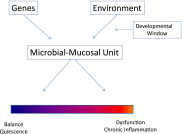The human microbiome. Early life determinant of health outcomes
- PMID: 24437411
- PMCID: PMC3972972
- DOI: 10.1513/AnnalsATS.201306-186MG
The human microbiome. Early life determinant of health outcomes
Abstract
The development of new technologies to isolate and identify microbial genomes has markedly increased our understanding of the role of microbiomes in health and disease. The idea, first proposed as part of the hygiene hypothesis, that environmental microbes influence the developmental trajectories of the immune system in early life, has now been considerably extended and refined. The abundant microbiota present in mucosal surfaces, especially the gut, is actively selected by the host through complex receptor systems that respond differentially depending on the molecular patterns presented to mucosal cells. Germ-free mice are more likely to develop allergic airway inflammation and show alterations in normal motor control and anxiety. These effects can be reversed by neonatal microbial recolonization but remain unchanged if recolonization occurs in adults. What emerges from these recent studies is the discovery of a complex, major early environmental determinant of lifetime human phenotypes. To change the natural course of asthma, obesity, and other chronic inflammatory conditions, active manipulation of the extensive bacterial, phage, and fungal metagenomes present in mucosal surfaces may be required, specifically during the developing years. Domesticating the human microbiome and adapting it to our health needs may be a challenge akin to, but far more complex than, the one faced by humanity when a few dozen species of plants and animals were domesticated during the transition between hunter-gatherer and sedentary societies after the end of the Pleistocene era.
Figures

Similar articles
-
The relationship between advances in understanding the microbiome and the maturing hygiene hypothesis.Curr Allergy Asthma Rep. 2013 Oct;13(5):487-94. doi: 10.1007/s11882-013-0382-8. Curr Allergy Asthma Rep. 2013. PMID: 23934550 Review.
-
The Role of Lung and Gut Microbiota in the Pathology of Asthma.Immunity. 2020 Feb 18;52(2):241-255. doi: 10.1016/j.immuni.2020.01.007. Immunity. 2020. PMID: 32075727 Free PMC article. Review.
-
The microbiome in asthma.J Allergy Clin Immunol. 2015 Jan;135(1):25-30. doi: 10.1016/j.jaci.2014.11.011. J Allergy Clin Immunol. 2015. PMID: 25567040 Free PMC article. Review.
-
Microbiome diversity and asthma and allergy risk.Curr Allergy Asthma Rep. 2014 Oct;14(10):466. doi: 10.1007/s11882-014-0466-0. Curr Allergy Asthma Rep. 2014. PMID: 25149168 Review.
-
Alteration of Lung and Gut Microbiota in IL-13-Transgenic Mice Simulating Chronic Asthma.J Microbiol Biotechnol. 2020 Dec 28;30(12):1819-1826. doi: 10.4014/jmb.2009.09019. J Microbiol Biotechnol. 2020. PMID: 33046682 Free PMC article.
Cited by
-
Prebiotics: A Novel Approach to Treat Hepatocellular Carcinoma.Can J Gastroenterol Hepatol. 2017;2017:6238106. doi: 10.1155/2017/6238106. Epub 2017 May 10. Can J Gastroenterol Hepatol. 2017. PMID: 28573132 Free PMC article. Review.
-
Childhood Asthma Inception and Progression: Role of Microbial Exposures, Susceptibility to Viruses and Early Allergic Sensitization.Immunol Allergy Clin North Am. 2019 May;39(2):141-150. doi: 10.1016/j.iac.2018.12.001. Immunol Allergy Clin North Am. 2019. PMID: 30954166 Free PMC article. Review.
-
Childhood nutritional stress and later-life health outcomes in medieval England: Evidence from incremental dentine analysis.Sci Adv. 2025 Aug;11(31):eadw7076. doi: 10.1126/sciadv.adw7076. Epub 2025 Jul 30. Sci Adv. 2025. PMID: 40737406 Free PMC article.
-
The microbiome in early life: implications for health outcomes.Nat Med. 2016 Jul 7;22(7):713-22. doi: 10.1038/nm.4142. Nat Med. 2016. PMID: 27387886 Review.
-
The pediatric microbiome and the lung.Curr Opin Pediatr. 2015 Jun;27(3):348-55. doi: 10.1097/MOP.0000000000000212. Curr Opin Pediatr. 2015. PMID: 25888147 Free PMC article. Review.
References
-
- Metchnikoff É. New York: Putman; 1903. The nature of man, studies in optimistic philosophy; p. 251.
-
- Douwes J, Pearce N. Commentary: the end of the hygiene hypothesis? Int J Epidemiol. 2008;37:570–572. - PubMed
Publication types
MeSH terms
Grants and funding
LinkOut - more resources
Full Text Sources
Other Literature Sources

